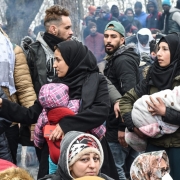Reckoning The Full Costs Of Endless War.
Nearly twenty years of warfare in eight countries have resulted in the forced displacement of at least 37 million people. Those are the findings of a recent report by the Costs of War project at Brown University’s Watson Institute for International and Public Affairs. It is the first time that there has been an attempt to calculate a comprehensive tally of the number of refugees and internally displaced persons (IDPs) driven from their homes by armed conflict in the post-9/11 era.
The 37 million figure comes from tracking the number of refugees, IDPs, and asylum seekers driven out by wars in which the U.S. has been involved either directly or in a supporting role. The total number of people displaced by war during this period is much higher, and 37 million represents a conservative estimate of the upheaval caused by these conflicts. When we consider the tens of millions of people whose lives have been uprooted and devastated by the wars that our government has started or joined, we are obliged to ask why we have allowed our government to contribute to so much unnecessary suffering in so many different parts of the world.
Iraq, Afghanistan, and Syria are the countries that have had the largest number of people displaced by war. These are the countries that have experienced the longest and the most intense warfare, so it is understandable that these wars generated the most refugees and IDPs. According to the report, wars involving the U.S. led to the displacement of 9.2 million Iraqis, 7.1 million Syrians, and 5.3 million Afghans. That is more than 21 million just from those three countries. Yemen (4.4 million), Somalia (4.2 million), Pakistan (3.7 million), the Philippines (1.7 million), and Libya (1.2 million) account for the rest. Most of those displaced have since been able to return, but that still leaves roughly 12 million people that cannot. As the report’s authors note, these raw numbers cannot assess the toll that the experience of displacement has taken on the people that have gone through it.
Displacement is a rather bloodless term for a horrifying ordeal in which people are forced to abandon everything they have known because they no longer feel secure in their own communities. There are few things more traumatic. David Vine, one of the report’s co-authors, observes, “Losing one’s home and community, among other losses, has impoverished people not just economically but also psychologically, socially, culturally and politically.” Being forced to live in camps or in the wilderness exposes these people to a host of other dangers, including abuse, disease, and starvation. Documenting the massive scale of the displacement across all of these countries is an important beginning of reckoning with the terrible price that these nations have paid, but it cannot fully capture the terrible conditions that displaced people have had to endure.
The report’s authors make clear that they do not fault the U.S. alone for this:
In documenting displacement caused by the U.S. post-9/11 wars, we are not suggesting the U.S. government or the United States as a country is solely responsible for the displacement. Causation is never so simple. Causation always involves a multiplicity of combatants and other powerful actors, centuries of history, and large-scale political, economic, and social forces. Even in the simplest of cases, conditions of pre-existing poverty, environmental change, prior wars, and other forms of violence shape who is displaced and who is not.
What they do insist on, however, is recognizing the role that the U.S. has had in escalating and intensifying existing conflicts and beginning new ones. Most of the costs of war are borne by the people that live in the countries where our government has chosen to intervene to one degree or another, and those costs must be acknowledged in any honest assessment of the policies that have inflicted this damage on tens of millions of innocent people. When we count the costs of our interventions, we need to include not only those civilians killed and injured in the ensuing conflicts, but also those that had to flee in fear of their lives. The wounds left by our many wars on two continents will take decades to heal, and fresh wounds continue to be made every day that the U.S. is still engaged in hostilities in several of these countries.
The U.S. role in creating the chaotic conditions for displacement in Iraq and Afghanistan may be obvious enough, but the other cases are very instructive. U.S. involvement in a conflict does not have to be direct or even all that large to contribute significantly to forced displacement of millions. The supporting role that the U.S. has had in the Saudi coalition’s war on Yemen, for example, has been limited in the sense that no U.S. troops are directly engaged in the fighting and no U.S. pilots are dropping the bombs that kill civilians and wreck the country’s infrastructure. But it has been quite extensive in providing logistical support, intelligence, weapons, and, until not that long ago, refueling for coalition jets. There is a reason why U.S. officials have been worried for years about being held liable for the war crimes committed by the Saudi coalition: the U.S. has been deeply complicit in the bombing and starving of Yemen for five and a half years. That support has also contributed to the displacement of more than four million people, most of whom have had to flee their homes because of the bombing or fighting between the coalition’s proxies and the Houthis since 2015.
Syria is a more fraught and complicated case, and it bears closer examination. The report limited its count of refugees and IDPs linked to a war involving the U.S. to just those territories in Syria where U.S. forces have been operating: “As a result, we focused our calculations on people displaced from five Syrian provinces where U.S. forces have fought and operated since 2014. A less conservative and arguably more accurate approach would include the displaced from all of Syria’s provinces since 2014 or as early as 2013 when the U.S. government began backing Syrian rebel groups.” It would not be hard to argue that the U.S. bears some responsibility for the consequences of arming anti-regime forces in Syria, so it is significant that the authors chose not to include displacement in areas where U.S.-armed proxies have operated. While some Syria hawks have disingenuously attacked the report because they find its evidence threatening to their constant agitation for deeper intervention, the authors are actually understating the effects of U.S. intervention in Syria.





